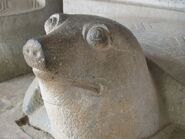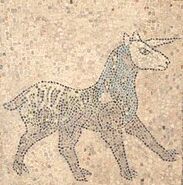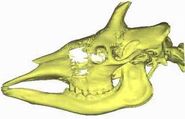Cryptozoology, the study of “hidden animals”, concerns itself with animals whose existence has not yet been recognized by mainstream science. These animals, known as “cryptids”, are often the stuff of legends, written off as myths or elaborate hoaxes. Some famous cryptids are Bigfoot, the Loch Ness Monster, and El Chupacabra, all of which remain shrouded in mystery. However, many animals widely recognized today were once among these cryptids. The following ten creatures were once dismissed by science as products of folklore, imagination, or deception, but are now formally recognized as their own species.
For the sake of consistency, animals falsely thought to be extinct have not been included (Coelacanth, Chacoan Peccary, Ivory-billed Woodpecker).
#1: Hoan Kiem Turtle (The Discovered God)[]
- Main article: Hoan Kiem Turtle
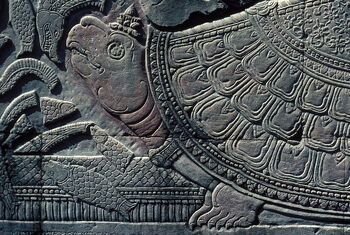
In Ancient Vietnamese mythology, Sword Lake or Hoan Kiem Lake was surrounded by the most sacred spot in the region. According to the legend, emperor Lê Lợi was boating on the lake when his magic sword, Heaven's Will, was grabbed by a turtle who quickly disappeared into the depths. All attempts to find either the sword or the turtle failed. Lợi concluded that the Golden Turtle God (Kim Qui) had come to reclaim the sword that it had given Lợi some time earlier, during his revolt against the Chinese Ming Dynasty. Lợi renamed the lake to commemorate this event, it was formerly known as Luc Thuy meaning "Green Water"). The Turtle Tower (Thap Rùa) standing on a small island near the centre of lake is linked to the legend. Turtle Tower , also called Tortoise Tower is a small tower in the middle of Sword Lake, Hanoi, Vietnam, which housed the corpse of the sacred turtle.
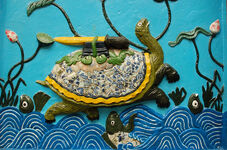
Kim Qui Turtle god at Hoan Kiem with Sacred Sword
The Hoan Keim Turtle was an important figure of Vietnamese Mythology, however scientists did not actually believe the turtle existed until on March 24, 1998, when a team of scientists video taped the creature, and later caught several live samples. This shocked the entire world, because an animal that was thought to have never existed and was considered a cryptid was proven real. This shows that although Cryptids might seem unrealistic, the turtle was described to have a walrus like head and pig nose, there still is a fairly decent chance that they exist in the remote regions of the world.
This is only one example of the success of cryptozoologists. Hundreds of people are working around the clock to clean up a lake in the heart of Vietnam's capital in hopes of saving a rare, ailing giant turtle that is considered sacred. Experts say pollution at Hanoi's Hoan Kiem Lake is killing the giant freshwater turtle, which has a soft shell the size of a desk. It is one of the world's most-endangered species, with only four believed alive worldwide.
Teams of people are cleaning debris, pumping fresh water into the lake and using sandbags to expand a tiny island to serve as a "turtle hospital." The rescuers may even try to net the animal for the first time as part of the effort. The Hoan Kiem turtle is rooted in Vietnamese folklore, and some even believe the creature that lives in the lake today is the same mythical turtle that helped a Vietnamese king fend off the Chinese nearly six centuries ago. It swims alone in the lake and in the past has been glimpsed only rarely sticking its wrinkled neck out of the water. But it has recently surfaced much more frequently, alarming the public with glimpses of raw open wounds on its head and legs. Meetings were called, a council was established and 10 government agencies were put to work to try to save it. It's the first time anyone has tried to capture the turtle, and Vietnamese have flocked to the lake in hopes of spotting it -- a sign of good luck -- as newspapers run daily articles about its plight.
#2: Hogzilla[]
- Main article: Hogzilla
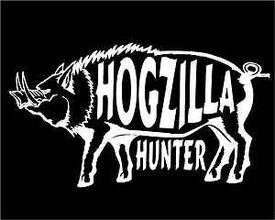
Extra-large animals are one of the staples of cryptozoology. Reports constantly flow in of critters that are much bigger than mainstream scientists will accept. One category of giant animals that gets reported from all over the world consists of giant hogs or huge wild boars. One example is Hogzilla, a proven cryptid that was once considered a hoax reported from the southern United States. At least two species of really big pigs have turned out to be real; the chacoan peccary in the nation of Paraguay in South America, and the giant forest hog in the nations of Kenya, Tanzania, Congo, Ghana, Cameroon, the Ivory Coast and Ethiopia in Africa. Both of these species are now recognized by science, even though both of them were once the subject of much ridicule. Another giant hog of legend turned out to be a real animal, but it was something other than a pig. This was the Pygmy Hippo, a rare animal that looks like a cross between a pig and a miniature Hippo.

Cover of the National Geographic Documentary
Hogzilla is the name given by Dr. Eliahu Katz to a male hybrid of wild hog and domestic pig that was shot and killed by Chris Griffin in Alapaha, Georgia, United States, on June 17, 2004 on Ken Holyoak's fish farm and hunting reserve. It was alleged to be 12 feet (3.7 m) long and weighed over 1,000 pounds (450 kg). It was originally considered a hoax. The animal's remains were exhumed in early 2005 and studied by Dr. Oz Katz and his father, Dr. Eliahu Katz, for a documentary and a book they wrote together. In March 2005, these scientists confirmed that Hogzilla actually weighed 800 pounds (360 kg) and was between 6.9 feet (2.1 m) and 8.6 feet (2.6 m) long, diminishing the previous claim. DNA testing was performed, revealing that Hogzilla was a hybrid of wild boar and domestic pig (Hampshire breed).
However, compared to most wild boars and domestics, Hogzilla is still quite a large and extraordinary specimen. Hogzilla's tusks measured nearly 28 inches (71 cm) and 19 inches (48 cm). Rumors have been flying around the Lone Star State regarding the shooting of a giant hog near Conroe, Texas. According to the email that has been making the rounds, an 1,800-pound wild boar was shot on the eastern outskirts of Conroe near the Lone Star Executive Airport. Many reports of property destruction due to wild hogs have come in from this area and pigs have been seen crossing high traffic areas for years in this vicinity. I had my doubts about this story from the start. I keep up with the goings on in East Texas pretty well and felt I would have heard something about this giant. It turns out I was right. According to The Courier of Montgomery County the boar was shot and killed in Turkey in 2005. The enormous hog was taken down by a .300-caliber rifle and weighed in at 781 pounds. This made it the largest hog ever taken in Turkey. Tales of giant feral hogs have become quite common in the South. Many are familiar with the story of “Hogzilla”, the hog killed in Georgia in 2004.
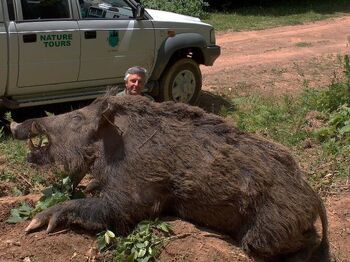
Texas's Hogzilla
Originally thought to be 12 feet long and over 1,000 pounds, “Hogzilla”, according to National Geographic experts, who unearthed the carcass, was only 8 feet long and weighed a mere 800 pounds. This would make it at least the equal of the hog taken in Turkey in 2005. Just last year, according to stories and photos circulating on the internet, an 11 year old boy killed a 1,051 pound hog that measured 9 feet 4 inches long. This claim, to my knowledge, has yet to be verified by Texas Parks & Wildlife officials. Even if the size of that hog turns out to be exaggerated as well, there is little doubt it was one huge pig. Wild hogs in the South continue to flourish and get bigger.
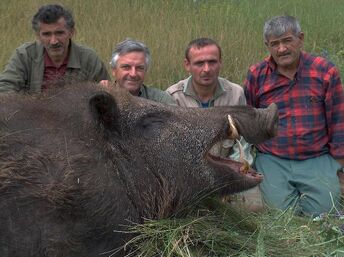
It is true that most hogs in Texas top out at around 300-350 pounds, however, reports continue to come in from hunters and others of hogs that are much bigger. Recently, Germany has reported a surge in the wild boar population. According to one study, "German wild boar litters have six to eight piglets on average, other countries usually only about four or five." Boar in Germany are also said to be becoming increasingly 'brazen' and intrude further into cities, for example Berlin. Wild boar attacks on humans are not common but do occur occasionally. Usually, boars, like most wild animals, will avoid interactions with humans. Due to the clearing of natural boar habitats, the number of interactions, including aggressive ones, between humans and boars has increased. When dealing aggressively with a human, boars will charge at them.
#3: Giant Squid (Cephalopod that was Once a Myth)[]
- Main article: Giant Squid
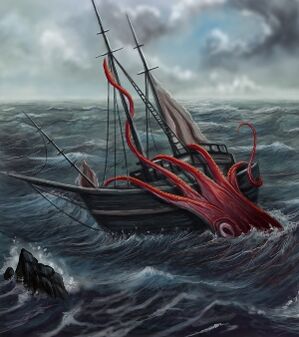
As Depicted in mythology
Tales of enormous squids have circulated throughout the world since ancient times. Aristotle and Pliny the Elder both described such monsters; legends such as the Lusca (Caribbean), Scylla (Ancient Greece), and the sea monk (Medieval Europe) all describe a bizarre, often dangerous nautical creature. Perhaps the most famous legendary squid is the Norse Kraken, a monstrous, tentacled beast as large as an island that devoured ships whole. Prior to the 1870s, scientific opinion held such creatures as nothing more than ridiculous myths, on par with mermaids or sea serpents.
Despite this, investigations into the existence of the legendary Kraken took place as early as the 1840s. Danish zoologist Johan Japetus Streensup methodically researched and catalogued giant squid sightings and strandings, eventually examining a beached corpse and designating the beast’s scientific name: Architeuthis. Even so, fellow scientists remained skeptical and continued to dismiss accounts.
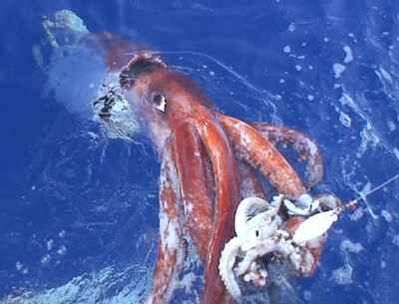
Photo of an Actual Giant Squid
In the 1870s, the skepticism stopped as several carcasses were beached in Labrador and Newfoundland. Tentacles and complete corpses revealed to the scientific world that the giant squid was indeed real. Today, this creature remains just as mysterious and rare. Typically living at great depths, giant squid sightings are uncommon and often undocumented. For a century, scientists dutifully attempted to observe it in its natural habitat, but failed. Only in 2004 were a group of Japanese scientists able to capture a live giant squid on camera, taking 500 automatic photographs before the creature swam back into the blackness.
Many questions remain concerning the giant squid. Very little is known about its habits and lifestyle, and it is still unknown how large a giant squid can grow. The largest specimens are between 30 and 40 feet long, weighing over 100 pounds. However, its close relative, the Colossal Squid, may grow to much greater sizes, as evidenced by the size of sucker marks on sperm whales. To this day, the giant squid remains a legendary example of how fantastic animals on earth can be.
#4: African Unicorn or Okapi (Icon of Cryptozoology)[]
- Main article: Okapi
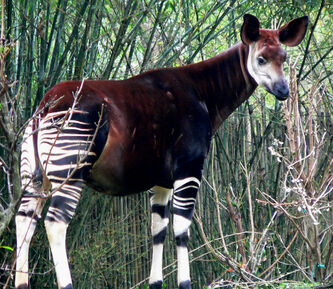
Central African tribes and ancient Egyptians described and depicted a bizarre creature for centuries, colloquially dubbed the “African unicorn” by Europeans. It is known locally by such names as the Atti, or the O’api, resembling a cross between a zebra, a donkey and a giraffe. Despite descriptions from explorers and even skins, Western science rejected the existence of such a creature, viewing it as nothing more than a fantastical chimera of real animals. Determined expeditions uncovered nothing, and it would seem the “African unicorn” was just as mythical as its namesake.
This changed in 1901 when Sir Harry Johnston, the British governor of Uganda, obtained pieces of striped skin and even a skull of the legendary beast. Through this evidence and the eventual capture of a live specimen, the animal now known as the okapi (okapia johnstoni) was recognized by mainstream science. The okapi is no less unusual today: it is the only living relative of the giraffe, sharing a similar body structure and its characteristic long blue tongue. However, the markings on its back legs resemble that of a zebra’s stripes. Okapis are solitary creatures that remain captivating to scientists; although not endangered, there is still much to learn about their habits and lifestyle.
The okapi was the symbol of the now defunct International Society of Cryptozoology, and remains a persisting icon of Cryptozoology to this day.
#5: Komodo Dragon (Beast of Indonesia)[]
- Main article: Komodo Dragon
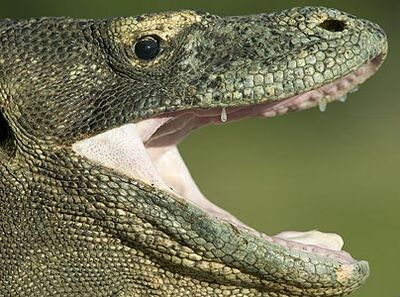
By the early twentieth century, Western science had determined that giant lizards were nothing more than a relic of the prehistoric past. Thus, when pearl fishermen returned from the Lesser Sunda Islands, in Indonesia, with tales of monstrous “land crocodiles”, their accounts were met with overwhelming skepticism. An expedition from the Buitenzorg Zoological Museum, in Java, produced a report of the creatures, but the legendary dragons of Komodo faded into obscurity as World War I took precedence.
Then, in 1926, an expedition from the American Museum of Natural History confirmed that the tales of giant lizards were true. W. Douglas Burden, the leader of the expedition, returned with twelve preserved specimens and two live ones. The world was introduced to the Komodo Dragon, a massive monitor lizard that grows up to ten feet, making it the largest lizard in the world. Komodo Dragons possess massive claws and fangs with which they can kill almost any creature on the island, including humans and water buffaloes. One particularly bizarre attribute of these creatures is their venomous bite, which has been attributed to bacteria-laden saliva or venom glands in the mouth.
The 1926 expedition to Komodo served as the inspiration for King Kong, in which a similar expedition to a foreign island reveals prehistoric megafauna.
#6: Sea Serpents[]
- Main article: Sea Serpents
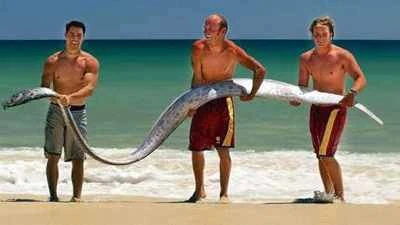
For centuries, the Sea Serpent persisted as the most captivating cryptozoological mystery in the world. Sightings of these mysterious, and often frightening, creatures have occurred plentifully throughout history, even up until the early twentieth century. From Northern European waters to the Eastern North American coast, tales of serpentine, aquatic beasts of colossal proportions dot the globe. Their descriptions vary, ranging from horse-headed creatures to massive snakes.
Cryptozoologists speculate that various misidentified animals can account for Sea Serpent sightings. However, one elusive species is a particularly likely source for many of these accounts. The Oarfish (or Ribbonfish) is a massive, elongated fish found worldwide. It is the longest of all bony fish, the largest recorded being 17 meters (56 ft) in length. Oarfish typically dwell in the deep ocean, but are occasionally washed ashore in storms, and linger at the surface near death. A live Oarfish was filmed for the first time in 2001, demonstrating its rarity and reclusive nature.
#7: Platypus (The Cute Chimera)[]
- Main article: Platypus
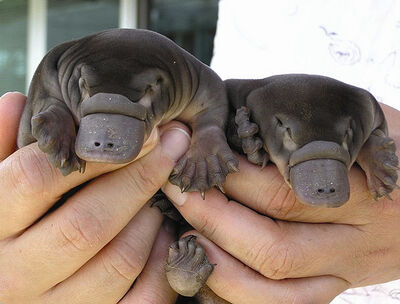
When European naturalists first encountered this bizarre creature, they were understandably baffled. Accounts described it as a venomous, egg-laying mammal with a duck bill and beaver tail. Many prominent British scientists deemed it a hoax when presented with a sketch and pelt, in 1798. Even when offered a corpse, scholars suspected that it was an elaborate, sewn-together fraud.
Today, this bizarre but fascinating creature is known as the platypus, one of only five extant monotremes (egg-laying mammals). While formally recognized by science, it is no less unique today: this semi-aquatic creature, native to eastern Australia, swims with webbed feet, uses electrolocation to hunt, and possesses an ankle spur that, in males, can deliver a powerful injection of venom. While non-lethal to humans, this venom is excruciatingly painful and is not responsive to most pain-killers.
#8: Bondegezou (Ancestral Spirit)[]
- Main article: Bondegezou
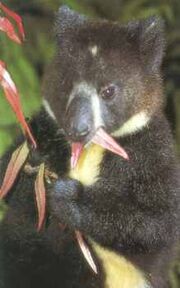
The Bondegezou (“man of the forests”) is a legendary, ancestral spirit of the Moni people in Western Indonesia. Described as a tree-dwelling creature, the Bondegezou resembles a small man covered in black and white fur. It is said to be a tree climber, but often stands on the ground in a bipedal stance.
In the 1980s, a photograph of the Bondegezou was sent to Australian research scientist Tim Flannery, who initially identified the creature as a young tree kangaroo. But in May, 1994, Flannery conducted a wildlife survey of the area and discovered that the animal in the picture was new to science. The Dingiso (Dendrolagus mbaiso), as the creature is also known, is a forest-dwelling marsupial with bold coloration that spends most of its time on the ground. The Dingiso remains a rare sight – the first real evidence of the creature was only skins, and to this day, no Dingiso exists in captivity.
#9: Ziphius (Water Owl)[]
- Main article: Ziphius (Cuvier's Beaked Whale)
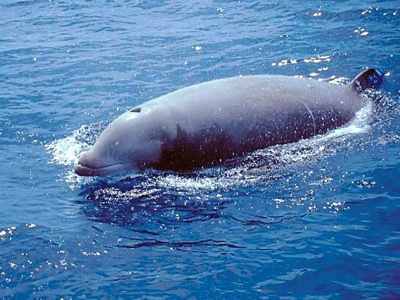
In Medieval folklore, the Ziphius, or “Water-Owl”, was a monstrous nautical creature said to attack ships in the northern seas. It possessed the body of a fish and the head of an owl, complete with massive eyes and a wedge-shaped beak. “Ziphius”, meaning “sword-like” in Latin, may refer to the beast’s fin, which was said to pierce the hulls of ships like a sword.
Today, the inspiration for the Ziphius is known as Cuvier’s Beaked Whale, a widespread species of beaked whale. Also known as the Goose-beaked whale, this creature is found as far north as the Shetland Islands and as south as Tierra Del Fuego at the tip of South America. It is the only member of the genus Ziphius, which bears the name of its legendary identity. Some additionally attribute the inspiration of the Ziphius to the orca or the great white shark, based on some depictions of the beast as a predator to seals.
#10: Devil Bird (Not Recognized as a Cryptid)[]
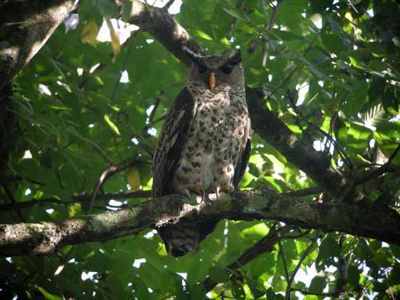
The Devil Bird, locally known as Ulama, is a frightening cryptid of Sri Lanka said to emit bloodcurdling human sounding shrieks in the night from within the jungles, which are said to resemble a wailing woman. In Sri Lankan folklore, it is believed that the cry of this horned bird is an omen that portends death.
This elusive creature is rarely seen, but is often heard in the form of its infamous, blood-curdling screams. For centuries, the nocturnal cries of the Devil Bird were the only evidence of its existence; Western science wrote if off as mere superstition.
Then, in 2001, the Devil Bird was identified as a new species of owl, the spot-bellied eagle owl (Bubo nipalensis). The largest of all Sri Lankan owls, Bubo nipalensis matches the description of the Ulama perfectly, down to its characteristic screech and tufted “horns”. Although some debate still remains as to the true identity of the Devil-Bird, the spot-bellied eagle owl stands as the most compelling source of inspiration for this mysterious creature.




